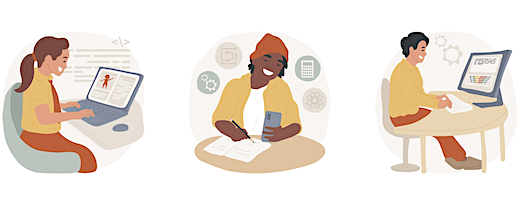Moving Past Old-School Definitions of Literacy
By Jason D. DeHart

What I found almost immediately was this: My students were much more engaged by contemporary and youth-minded writer voices that spoke to relevant issues they cared about.
While canonical print texts might have been venerated for decades by adults, my students did not connect with these books in the same way they did contemporary YA novels.
From there, I began to learn and grow in my understanding and knowledge of middle grade and young adult fiction. At the same time, technology was continuing to grow at an extraordinary rate, leading to more and more engagement beyond a printed page.
In a series of five posts throughout the coming school year, I’ll be exploring what reading and writing means now – and how teachers can embrace a wide range of literacy practices for the benefit of their students who are striving, as well as those who are thriving.
A New Day – What’s changed? What’s the same?
What does it mean to read, write and compose in an age that is dominated by screens and devices?
Digital literacy was part of my life growing up, but forms and platforms have shifted so much since then. My teaching career started in 2007 and, as I write this, it is now 2023. My students today live in a world that runs on technology. AI has begun its march across the learning landscape. My reliance on paper engagements has been replaced with assigned laptops, and an interactive screen lives at the front of my room. My classroom is enriched by tech.
We have also just experienced a pandemic period in which screens were essential for maintaining safe and healthy connections. Teachers quickly learned about hybridized approaches and the relationship between tech and engagement. More than ever, we should now be prepared to meet our students where they are.
From day one of my career, I have had students who would rather not read. As an advocate for choice reading, I continue to be a book advocate, and I am always reading, interviewing authors, and adding books to my collection. I still love print, but I recognize that reading is about more than that.
I want to recognize that my students are, in fact, highly literate human beings whose understanding of literacy has been shaped by an age of screens and digital interactions. The same student who might not readily pick up a print text will spend hours navigating the world of digital media and screen content, via the cellular devices that almost all of them carry in their pockets.
My students are, in fact, readers of the digital world.
Visions of the future
Visionary authors like Isaac Asimov foresaw much of what is now happening in the world of technology, and one need only briefly peruse the pages of a 1990s Michael Crichton thriller or Daniel H. Wilson’s Robopocalypse (2011) to consider the dark side of technology. When it comes to digital reading and creating, there can be a disconcerting sense of the unknown that can quickly lead into the “thou shalt not” approach to teaching with tech.
Thou shalt not share thy information with people online – good advice, for sure. Thou shalt manage thy technology with care – also not a negative dictum, and the cracked screens I see each day are a testament to its applicability.
And, yet – there is more. Students have connections to a world-wide audience, mostly for the better. Publication is no longer an esteemed and elite possibility reserved only for the few who happen to be in the right place or know the right people.
Writing and creating is open access, and accessibility is a key term. Tools are now available – audio, video, transcription, chatbots – which create possibilities for students who find the traditional mechanics of composing difficult or otherwise unattainable.
Today’s destinations
With so many possibilities, where we can take students next? Where can they can take us? Let’s look at some destinations.
► Digital Stories are hardly new. There is research dating back to the early 2000s about how stories are opened up and shared by technology. What seems to be constantly refreshing are the ways students can compose, from online book-making sites that are interactive to the affordances of social media venues for creating and sharing vlogs. As new online spaces come to be, there are even more ways for all students to engage in literacy. Voice is important, and digital tools allow for a wide range of ways to compose, share stories, and reflect on the experience.
Assumptions can creep in, and I love how technology troubles these first impressions. I am thinking of a student I worked with in late 2022 who was not an avid reader on the surface, but who one day disclosed that they had a blog. How does a student who is not readily engaging with the written word (so far as the teacher knows or assumes) then create and share an ongoing literate video space?
The tools are at hand and the motivation is there for us to tap into, if we make our tasks flexible and relevant to Generation Z learners.
► (Safe) Connections. It is absolutely true that young people should be careful about the connections they create and foster, both in their F2F communities and in digital communities, and that adults have an important role in facilitating safe interactions. There are, however, positive connections that can be built. As a proponent of student authoring, I’ve learned virtual author visits can be a strong step in a positive direction. Just as audience and publication are now within reach, so too are many authors who can speak about storytelling, self-expression, and the craft of writing and how those things connect to the lives of young people.
Virtual pen pals have replaced the days of students sending letters in the mail, and scratchy telephone voices are now replaced with video conferencing technology, offering us the option to connect classroom to classroom in world-view expanding ways. Teacher-author Kelly Gallagher spoke with me about this type of work recently (linked here), and noted the possibilities of composing with relevant purpose and a connected audience.
The Internet offers a wide range of video and audio tools, as well as examples that can serve as mentor texts for thinking about how composing can take place – including rather than replacing the written word. Such examples can come from both well-established voices and new artists.
A carefully-chosen piece of music, brief recording, or personal photographic essay can support the evocative power of a text. In the photographic essay example, students explore their personal experiences and culture through brief, well-honed vignettes that accompany each image, creating a powerful narrative.
Reflecting on rigor
In the final analysis, teachers can ask themselves what is most engaging and relevant for students. Classrooms that exist as artifacts of what once was – or spaces for practicing what is and what might be? I conclude this post with a few reflection questions we can ask ourselves about maintaining rigor with digital composing.
- How does the use of digital tools support my learners who need tech accessibility, while also serving as a series of challenging next steps for students who need additional opportunities to extend their thinking?
- How can a digital text that is multimodal be read critically and closely? Is this different from the way students might analyze a passage in a textbook?
- In what ways can students safely interact with tech accessible tools and see themselves as authors as a part of their classroom experience?
I look forward to sharing more from my classroom in future posts!
ALSO SEE:
Jason’s article on cross-teaching text and graphic novels:
Serafina: Pairing Graphic Novels with Their Text Originals
Dr. Jason D. DeHart teaches English at Wilkes Central High School in Wilkesboro, North Carolina. He taught English Language Arts to middle grades students in Cleveland, Tennessee for eight years, earned his doctorate, and served as an assistant professor of reading education at Appalachian State University before returning to his first love, the secondary classroom.
Jason’s work has appeared in Edutopia, SIGNAL Journal, English Journal, The Social Studies, and the NCTE Blog. See all of Jason’s MiddleWeb posts here – including a 3-part series with teacher and school librarian Jennifer Sniadecki on using picture books with middle level readers. His website Book Love: Dr. J. Reads offers book reviews and author interviews.































